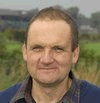Arla approves herd expansion

Milk buyer Arla has approved Peter Chapman’s herd expansion, but he will have to take the price he gets for some of the extra milk. Wendy Short reports
Peter Chapman’s business is on course to move from 160 to 200 cows over the next few years, and milk buyer Arla has given the green light to his expansion plan. But the company has said it will only pay full price for 50% of the anticipated increase in milk, leaving the surplus at the mercy of end-of-month market prices.
“I had half expected this decision,” says Mr Chapman. “Arla has agreed an increase of 200 litres a day, when our target is to be producing an extra 400 litres, which equates to a 10-12% production rise.
“As the market price is generally lower than the forward price, I will have to achieve maximum production in late summer and autumn, when the open market figure reaches its peak.
“I am not tempted to switch milk buyers, because income always dips during the changeover period, and I have already moved away from supplying First Milk.”
Winter ration
Mr Chapman also needs to ensure the herd produces as much milk as possible this November, when his limit will be set for the year ahead. So most cows have already been served with the aim of calving from June to November. He may also start feeding a winter-style ration to newly calved cows from August onwards.
Poor second- and third-cut silage yields last year have meant forage stocks are running low. With the final clamp already open, Mr Chapman may have to buy in extra feed, although he is not sure of the availability of a good quality, local supply.
To combat previous problems with chopped straw blocking the slurry channels in the dairy buildings, Mr Chapman has switched to using paper waste as cubicle bedding.
Around £3500 has been invested in a new paper waste dispenser, and Peter estimates he will spend £3000 on the EnviroBed paper product over the winter.
Policy change
The change in policy has worked well, because it saves valuable time spent on clearing the grids, as well as bringing other benefits.
“We also needed a more free-flowing material for distribution through the umbilical spreading system,” he explains. “The chopped straw thickened the waste, which made spreading more difficult.
“It used to take nearly an hour to bed up three times a week with the chopped straw, but it now takes only 15 minutes. The only downside is finding a space for paper storage, as it comes in 27t loads that have to be kept dry.”
Technology at Thornton Grange has brought mixed fortunes over the last couple of weeks. A new security system, installed following a break-in before Christmas, has been declared a very worthwhile investment. Not only does it capture images of anyone coming up the drive, it also sounds an alarm and records the time and date of their visit – welcome or not.
But Mr Chapman’s farm computer has succumbed to a serious virus. All the data have been retrieved, but the business has had the added expense of having to buy a replacement.
Frustration
On top of all this, Mr Chapman continues to juggle project-managing the construction of the new milking parlour that will accommodate the extra cows. Like most farmers, Mr Chapman finds he has a wide range of skills to his name but not much time, a combination which is causing him increasing frustration.
The steel frame is up and a number of fiddly jobs, like laying the water pipes and building the concrete pit, have been crossed off the list.
In an ideal world, Mr Chapman would like to take on a temporary, part-time worker to help with odd jobs, giving him more time to dedicate to the building work. But he is not optimistic about his chances of finding the right person, and will continue to juggle his heavy workload.
Milk production figures
- Rolling margin over purchased feed: £1050 a cow
- Feed cost/litre: 4.15p
- Feed kg/litre: 0.29
- Milk value/cow: £1350
- Rolling-average milk price: 17.8p
- More information on Thornton Grange Farm
- More information on other Management Matter farms
